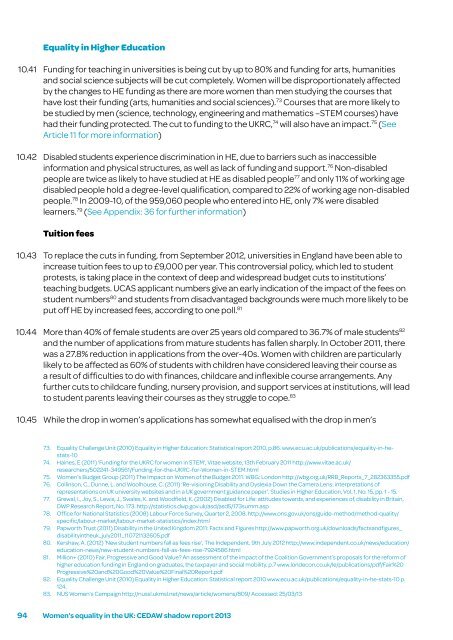Women’s equality in the UK – A health check
Women’s equality in the UK – A health check
Women’s equality in the UK – A health check
Create successful ePaper yourself
Turn your PDF publications into a flip-book with our unique Google optimized e-Paper software.
10.41<br />
10.42<br />
10.43<br />
10.44<br />
10.45<br />
Equality <strong>in</strong> Higher Education<br />
Fund<strong>in</strong>g for teach<strong>in</strong>g <strong>in</strong> universities is be<strong>in</strong>g cut by up to 80% and fund<strong>in</strong>g for arts, humanities<br />
and social science subjects will be cut completely. Women will be disproportionately affected<br />
by <strong>the</strong> changes to HE fund<strong>in</strong>g as <strong>the</strong>re are more women than men study<strong>in</strong>g <strong>the</strong> courses that<br />
have lost <strong>the</strong>ir fund<strong>in</strong>g (arts, humanities and social sciences). 73 Courses that are more likely to<br />
be studied by men (science, technology, eng<strong>in</strong>eer<strong>in</strong>g and ma<strong>the</strong>matics <strong>–</strong>STEM courses) have<br />
had <strong>the</strong>ir fund<strong>in</strong>g protected. The cut to fund<strong>in</strong>g to <strong>the</strong> <strong>UK</strong>RC, 74 will also have an impact. 75 (See<br />
Article 11 for more <strong>in</strong>formation)<br />
Disabled students experience discrim<strong>in</strong>ation <strong>in</strong> HE, due to barriers such as <strong>in</strong>accessible<br />
<strong>in</strong>formation and physical structures, as well as lack of fund<strong>in</strong>g and support. 76 Non-disabled<br />
people are twice as likely to have studied at HE as disabled people 77 and only 11% of work<strong>in</strong>g age<br />
disabled people hold a degree-level qualification, compared to 22% of work<strong>in</strong>g age non-disabled<br />
people. 78 In 2009-10, of <strong>the</strong> 959,060 people who entered <strong>in</strong>to HE, only 7% were disabled<br />
learners. 79 (See Appendix: 36 for fur<strong>the</strong>r <strong>in</strong>formation)<br />
Tuition fees<br />
To replace <strong>the</strong> cuts <strong>in</strong> fund<strong>in</strong>g, from September 2012, universities <strong>in</strong> England have been able to<br />
<strong>in</strong>crease tuition fees to up to £9,000 per year. This controversial policy, which led to student<br />
protests, is tak<strong>in</strong>g place <strong>in</strong> <strong>the</strong> context of deep and widespread budget cuts to <strong>in</strong>stitutions’<br />
teach<strong>in</strong>g budgets. UCAS applicant numbers give an early <strong>in</strong>dication of <strong>the</strong> impact of <strong>the</strong> fees on<br />
student numbers 80 and students from disadvantaged backgrounds were much more likely to be<br />
put off HE by <strong>in</strong>creased fees, accord<strong>in</strong>g to one poll. 81<br />
More than 40% of female students are over 25 years old compared to 36.7% of male students 82<br />
and <strong>the</strong> number of applications from mature students has fallen sharply. In October 2011, <strong>the</strong>re<br />
was a 27.8% reduction <strong>in</strong> applications from <strong>the</strong> over-40s. Women with children are particularly<br />
likely to be affected as 60% of students with children have considered leav<strong>in</strong>g <strong>the</strong>ir course as<br />
a result of difficulties to do with f<strong>in</strong>ances, childcare and <strong>in</strong>flexible course arrangements. Any<br />
fur<strong>the</strong>r cuts to childcare fund<strong>in</strong>g, nursery provision, and support services at <strong>in</strong>stitutions, will lead<br />
to student parents leav<strong>in</strong>g <strong>the</strong>ir courses as <strong>the</strong>y struggle to cope. 83<br />
While <strong>the</strong> drop <strong>in</strong> women’s applications has somewhat equalised with <strong>the</strong> drop <strong>in</strong> men’s<br />
73. Equality Challenge Unit (2010) Equality <strong>in</strong> Higher Education: Statistical report 2010, p.86. www.ecu.ac.uk/publications/<strong>equality</strong>-<strong>in</strong>-hestats-10<br />
74. Ha<strong>in</strong>es, E (2011) ‘Fund<strong>in</strong>g for <strong>the</strong> <strong>UK</strong>RC for women <strong>in</strong> STEM’, Vitae website, 13th February 2011 http://www.vitae.ac.uk/<br />
researchers/502241-349561/Fund<strong>in</strong>g-for-<strong>the</strong>-<strong>UK</strong>RC-for-Women-<strong>in</strong>-STEM.html<br />
75. <strong>Women’s</strong> Budget Group (2011) The Impact on Women of <strong>the</strong> Budget 2011. WBG: London http://wbg.org.uk/RRB_Reports_7_282363355.pdf<br />
76. Coll<strong>in</strong>son, C., Dunne, L. and Woolhouse, C. (2011) ‘Re-vision<strong>in</strong>g Disability and Dyslexia Down <strong>the</strong> Camera Lens: <strong>in</strong>terpretations of<br />
representations on <strong>UK</strong> university websites and <strong>in</strong> a <strong>UK</strong> government guidance paper’. Studies <strong>in</strong> Higher Education, Vol. 1, No. 15, pp. 1 - 15.<br />
77. Grewal, I., Joy, S., Lewis, J., Swales, K. and Woodfield, K. (2002) Disabled for Life: attitudes towards, and experiences of, disability <strong>in</strong> Brita<strong>in</strong>,<br />
DWP Research Report, No. 173. http://statistics.dwp.gov.uk/asd/asd5/173summ.asp<br />
78. Office for National Statistics (2008) Labour Force Survey, Quarter 2, 2008. http://www.ons.gov.uk/ons/guide-method/method-quality/<br />
specific/labour-market/labour-market-statistics/<strong>in</strong>dex.html<br />
79. Papworth Trust (2011) Disability <strong>in</strong> <strong>the</strong> United K<strong>in</strong>gdom 2011: Facts and Figures http://www.papworth.org.uk/downloads/factsandfigures_<br />
disability<strong>in</strong><strong>the</strong>uk_july2011_110721132605.pdf<br />
80. Kershaw, A. (2012) ‘New student numbers fall as fees rise’, The Independent, 9th July 2012 http://www.<strong>in</strong>dependent.co.uk/news/education/<br />
education-news/new-student-numbers-fall-as-fees-rise-7924586.html<br />
81. Million+ (2010) Fair, Progressive and Good Value? An assessment of <strong>the</strong> impact of <strong>the</strong> Coalition Government’s proposals for <strong>the</strong> reform of<br />
higher education fund<strong>in</strong>g <strong>in</strong> England on graduates, <strong>the</strong> taxpayer and social mobility. p.7 www.londecon.co.uk/le/publications/pdf/Fair%20<br />
Progressive%20and%20Good%20Value%20F<strong>in</strong>al%20Report.pdf<br />
82. Equality Challenge Unit (2010) Equality <strong>in</strong> Higher Education: Statistical report 2010 www.ecu.ac.uk/publications/<strong>equality</strong>-<strong>in</strong>-he-stats-10 p.<br />
124.<br />
83. NUS <strong>Women’s</strong> Campaign http://nussl.ukmsl.net/news/article/womens/809/ Accessed: 25/03/13<br />
94 <strong>Women’s</strong> <strong>equality</strong> <strong>in</strong> <strong>the</strong> <strong>UK</strong>: CEDAW shadow report 2013


